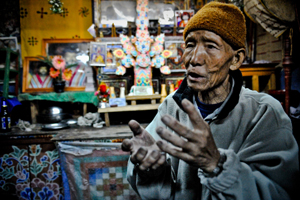
There is a seemingly hidden problem for Asia in providing economic, social and emotional security for the elderly. But drawing on the experiences of more developed economies, I think there is a silver lining behind this—an opportunity if actions are taken now to provide care and to give dignity to the elderly in Asia.
Why do I call it a hidden problem? There are a host of reasons but the more important ones include demographic shifts, poverty, and vulnerability among elderly, loosening of family ties and responsibilities, and the eminent role of the state in providing social and economic security for elderly.
First, it is common knowledge that life expectancy in developed and developing countries has increased over the past several decades and continues to rise. However, according to the International Labor Organization, it may come as a surprise that the ratio of elderly people is rising faster in developing countries than in the developed world. In Asia, where life expectancy was just 41.2 years from 1950–1955, it is now expected to reach 70.3 years for 2010–2015—an additional 30 years of active life. As well as increasing life expectancy, birth rates have also decreased in many parts of the world, resulting in a demographic shift where the percentage of the population comprising people over 60 is growing rapidly. This has resulted in rising economic dependencies.
Second, there is a common belief that the elderly are much poorer and more vulnerable than other age groups in developing countries. Older people often rely on income from meager savings and support from family. A majority of the world’s older people in developing countries of Asia have no formal social security support such as pension schemes and health insurance. The elderly are also vulnerable because they are more likely to have health problems. When they are ill they often have insufficient cash to pay for medical services, and in Asia few have health insurance.
Third, most elderly in Asia have always relied on family members to provide financial support and care but in many places these family ties are beginning to disappear. The reasons include smaller family sizes, young people moving out of family homes in rural areas, more women working outside the home, modern life styles and cultural changes that tend to diminish the expectation that children will take care of their parents in old age.
Fourth, are the current levels of social protection programs for the elderly. An Asian Development Bank study of programs in the Asia and Pacific region shows that formal social protection programs cover only about 10% to 15% of the total elderly. The rest must cater to their own needs. A vast number of elderly people are employed in the informal economy and have little or no access to any contributory social security schemes.
The lack of income and health security for older people in developing economies is compounded by the fact that long-term care is not readily available and most of those requiring such support must rely on informal home care, or services provided by unpaid caregivers such as family members. In developed economies, where the cost of long-term care is very expensive, most Western European countries have put in place a mechanism to fund formal care, and in a number of Northern and Continental European countries arrangements exist to at least partially fund informal care as well.
Despite the high costs, however, the picture is not as bleak as we might imagine for elderly in Asia. Long-term care can be provided both formally and informally. The setting can be either at home or in an institution or day-care center with services varying from selected support (cooking, laundry, housekeeping) to full 24/7 care, including medical. These facilities may go under various names, such as nursing home, personal care facility, residential continuing care facility, etc.
Of course, the challenges of providing long-term care services in developing countries are enormous and include financial, administrative, human resource and insurance issues, to name just a few. However, by acting early and engaging with key stakeholders, addressing these problems becomes less daunting.
This article was first published by the ADB Development Blog.







Comments are closed.